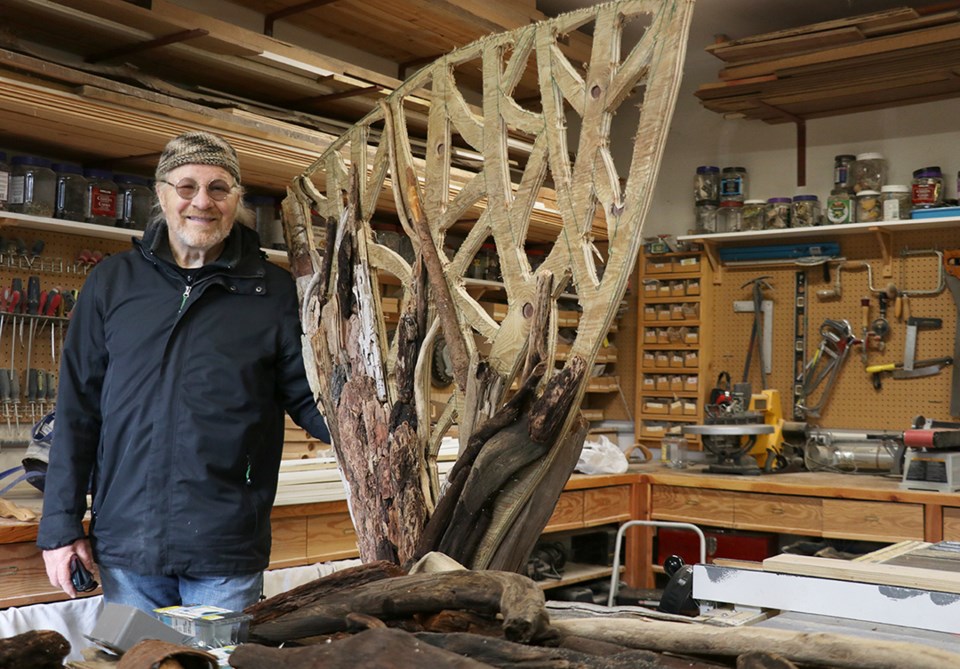In the depths of December, humans look for light.
Just as islanders have decorated Christmas trees in the Cove with lights for nearly two decades as a Bowen Children’s Centre fundraiser, this year Shirat HaYam (Bowen’s Jewish community) will display a lit-up driftwood menorah.
Matthew van der Giessen spent the past couple of months collecting driftwood on along Bowen beaches and affixing it to a six-foot menorah in the Belterra workshop.
The initiative came about following an anti-Semitic encounter on Bowen this past summer. The idea is to raise the visibility of the Jewish community on the island and educate people about Jewish culture and experience.
But the decision to let the symbol shine in the Cove, alongside the habitual suite of Christmas trees, wasn’t an easy one.
“For many Jews, that there's this tendency to not want to ask for trouble, to keep a low profile,” van der Giessen says. “There was certainly some very serious discussion about whether this was even something we should do.”
But everyone decided that it was important to step forward.
A Hannukah menorah is a nine-branched candelabra. Its eight candles represent the eight nights of the holiday and one candle to help light the others. The holiday follows a lunar calendar so can start in early November or late December.
The driftwood menorah will join the Christmas trees that are part of the Bowen Children’s Centre’s Festival of Trees in the grassy area next to USSC Marina.
Shirat HaYam will start lighting the lights with the first candle on the evening of Nov. 28, the first night of Hannukah this year. They will light a candle each of the following nights.
They invite all of the Bowen Island community to join for the seventh night of lighting, December 4. “There will be songs, treats and perhaps even that quintessential Jewish gambling game, the dreidel,” says van der Giessen.
Van der Giessen, the son of Unitarians, converted to Judaism as an adult and as a part of that process, studied Jewish scriptures and religion. He says that the early language used to describe Hannukah was as a festival of light.
“It seemed like this was a really interesting place to join with the rest of the community, around the season of ‘how do we find light in darkness?’ and to make our contribution to that.”
The Bowen Children’s Centre has hosted the Festival of Trees since 2002. When BCC’s executive director Ann Silberman asked a long-time staff member why they didn’t call it a festival of light back then, the answer was that the name was to honour Bowen – the island full of trees.
The wooden menorah – itself covered in pieces of trees – is an exciting addition to the festival for Silberman.
“We've been trying to make this festival more inclusive for years,” she says. “We want to keep honouring Christmas and people who celebrate Christmas, as I think the majority of people in our culture on Bowen Island do, but we want to open it up, to bring in some education and awareness.
“In the month of December, there are 15 cultures that celebrate with light. They're all about the end of the growing season, the end of the year and light and the newness that's coming.”
At the beginning of December, Silberman invites BCC families to bring their traditions into the classroom. So where Santa Claus no longer visits as part of BCC programming, he’s more than welcome — encouraged! — to visit as part of families’ holiday tradition.
At the Festival of Trees, it’s no longer just Christmas tunes playing in the background but a more eclectic mix.
“We've moved forward in small steps in several ways and this is a big way,” says Silberman. “It makes a gentle opening so that people are not threatened by other cultural celebrations and it opens a door for discussions.
“They can embrace it in the sense that ‘isn't it great that more of our community are standing up together to celebrate whatever it is?’”
Silberman professionally and personally knows of what she speaks. She has worked in early childhood education since 1980 (and at BCC for 20 of the past 30 years). She also started celebrating Hannukah as an adult while raising her son in a multi-cultural household. Silberman’s husband is Jewish (although not religious); Silberman is not.
Ideas about other cultures and other people come from what you build as a child, says Silberman. “Giving your child ideas about other cultures is really important. The way that you can do it is by exposure, because if you don't understand it yourself, what you may give them is fear.
“And the way to work through fear is to face it. It’s to find out more about another culture, to honour it. To respect it by trying to understand it. And by trusting that your child will make the right decisions in their life.
“You don't have to lead them to the conclusions. All you have to do is invite the to explore – they will come to their own conclusions.”
The inclusion of the menorah also comes as people try to figure out how to celebrate the holidays in the second year of COVID-19.
As van der Giessen puts it, the early descriptions of Hannukah are like those of many of the December celebrations: lighting of lights in darkness.


